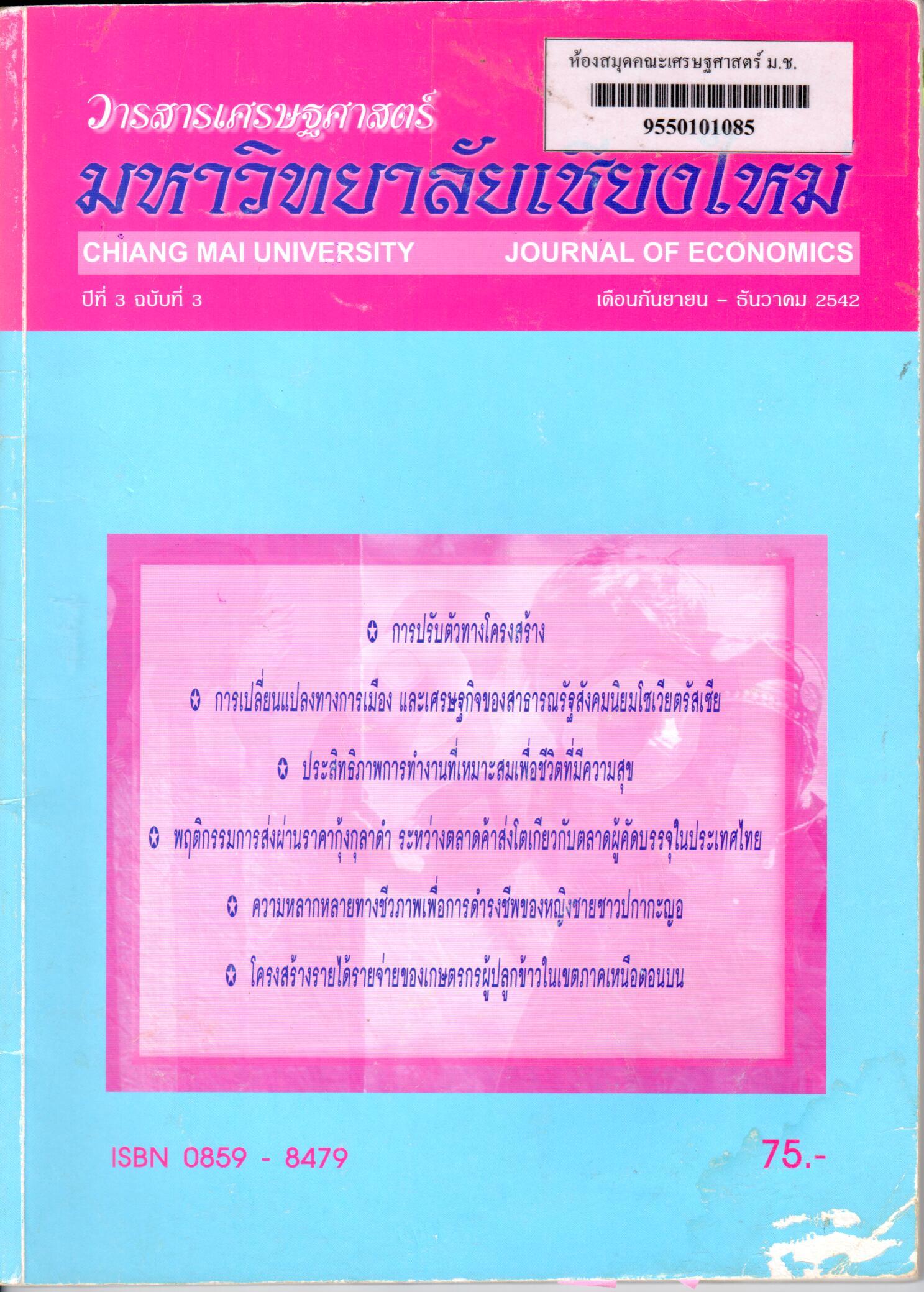ความหลากหลายทางชีวภาพเพื่อการดำรงชีพของหญิงชายชาวปะกากะญอ
Abstract
บทคัดย่อ
การศึกษาครั้งนี้มีวัตถุประสงค์เพื่อการศึกษาชนิด รูปแบบ และแหล่งของการใช้ประโยชน์ของพรรณพืชป่าที่ชาวปกากะญอทั้งหญิงและชาย เพื่อการบริโภคและการใช้ประโยชน์ในครัวเรือน มีการเก็บข้อมูลในครัวเรือน 30 ครัวเรือนในอำเภอแม่แจ่ม จังหวัดเชียงใหม่ และการเก็บตัวอย่างพรรณไม้ป่าอยู่อย่างน้อย 203 ชนิด ที่ชาวปะกากะญอรู้จักและใช้ประโยชน์ หญิงชาวปะกากะญอในหมู่บ้าน ที่ศึกษาเก็บพรรณไม้มากชนิดและในปริมาณที่มากกว่าชาย (190 ชนิด เทียบกับ 150 ชนิด) หญิงในกลุ่มฐานะยากจนมีการพึ่งพาการเก็บพรรณไม้เพื่อใช้ในครัวเรือนมากกว่ากลุ่มอื่นๆ พรรณไม้ที่หญิงและชายปะกากะญอเก็บอาจจำแนกออกเป็น 5 กลุ่มใหญ่ คือ อาหาร อาหารสัตว์ สีย้อมผ้า ยาสมุนไพร และไม้ฟืน ปริมาณเฉลี่ยที่เก็บโดยหญิง เท่ากับ 129 456 133 และ 2,368 กก. ต่อคนต่อปีในกลุ่มพรรณพืชดังกล่าวข้างต้นตามลำดับ ส่วนชายเก็บในปริมาณเท่ากับ 50 115 1 8 และ 76 กก. ต่อคนต่อปี ตามลำดับ
ปัจจุบันความหลากหลายและปริมาณของพรรณพืชป่าลดลงอย่างมาก ตามจำนวนประชากรและการใช้ที่เพิ่มขึ้นมีพรรณไม้ 4 ชนิดที่หาไม่ได้อีกแล้วรอบๆหมู่บ้าน พรรณไม้ 6 ชนิด ยังหาได้ แต่ต้องเข้าป่าไปเก็บและ อีก 11 ชนิด เริ่มที่จะหายาก เพื่อตอบสนองการลดลงของความหลากหลายทางชีวภาพนี้ ได้มีการนำพรรณพืชป่ามาปลูกในสวนรอบบ้าน โดยเฉพาะในกลุ่มผู้หญิง
Abstract
The objectives of the study were to study the types, patterns of use and sources of wild plants collected by Karen men and women for domestic consumption and utilization. Data was collected among 30 households in three Karen villages in Mae Chaem District, Chiang Mai Province, Thailand. Samples of wild plant species were also collected for identification. The study found that at least 203 wild plant species were known and used by the villagers. Women from these three villages collected more species of wild plants than men (190 vs. 115) All wild plant species collected by men and women could be grouped into 5 main groups viz. food, fodder, dyes, medicine, and fuelwood. Poor women are found to be more dependent on wild plants for their domestic use than other groups.
The average quantities of wild food plant species fodder, dyes, medicine, and fuelwood (in baskets) collected by women were 129, 456, 13, 3, and 2,368 kg. per person per year while men collected 50, 115, 1, 8, and 76 kg. per person per year of the same categories, respectively.
Presently the diversity and quantities of wild plants are decreasing because of increased population and use. Four species have been seriously decreased and are not available around the villages.
Six species have decreased seriously but are still available in the forest near the villages. Eleven species have begun to decrease. As a response to decreasing forest biodiversity, a number of wild food plant species were domesticated in home gardens, mostly by women.
Downloads
Issue
Section
License
All opinions and contents in the CMJE are the responsibility of the author(s). Chiang Mai University Journal of Economics reserves the copyright for all published materials. Papers may not be reproduced in any form without the written permission from Chiang Mai University Journal of Economics.
ข้อคิดเห็นที่ปรากฏและแสดงในเนื้อหาบทความต่างๆในวารสารเศรษฐศาสตร์มหาวิทยาลัยเชียงใหม่ ถือเป็นความเห็นและความรับผิดชอบโดยตรงของผู้เขียนบทความนั้นๆ มิใช่เป็นความเห็นและความรับผิดชอบใดๆของวารสารเศรษฐศาสตร์ มหาวิทยาลัยเชียงใหม่
บทความ เนื้อหา และข้อมูล ฯลฯ ในวารสารเศรษฐศาสตร์มหาวิทยาลัยเชียงใหม่ ถือเป็นลิขสิทธิ์เฉพาะของคณะเศรษฐศาสตร์มหาวิทยาลัยเชียงใหม่ หากบุคคลหรือหน่วยงานใดต้องการนำทั้งหมดหรือส่วนหนึ่งส่วนใดไปเผยแพร่ต่อหรือเพื่อกระทำการใดๆ จะต้องได้รับอนุญาตเป็นลายลักษณ์อักษร จากวารสารเศรษฐศาสตร์ มหาวิทยาลัยเชียงใหม่






